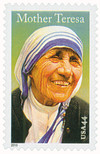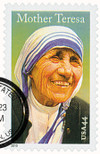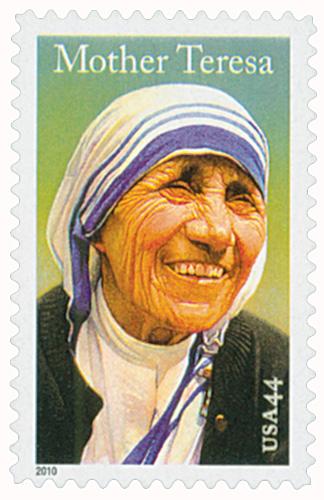
# 4475 - 2010 44c Mother Teresa
2010 44¢ Mother Teresa
Issue Date: September 5, 2010
City: Washington, DC
Happy Birthday Mother Teresa
When she was 18 years old, Agnes left her home country in Southeastern Europe to join the Sisters of Loreto in Dublin, Ireland. This was her first journey to a distant land with customs and a language that were new to her.
In 1928, she took the name Sister Mary Teresa and began her service to others. She was sent to Calcutta, India, where she taught for many years, eventually becoming headmistress of St. Teresa’s School. She enjoyed the time she spent teaching, but felt that she should be doing more. Mother Theresa believed she was “to give up even Loreto where I was very happy and to go out in the streets.” In order to answer her calling, this dedicated woman once again left the security of what she knew to travel to the unknown.
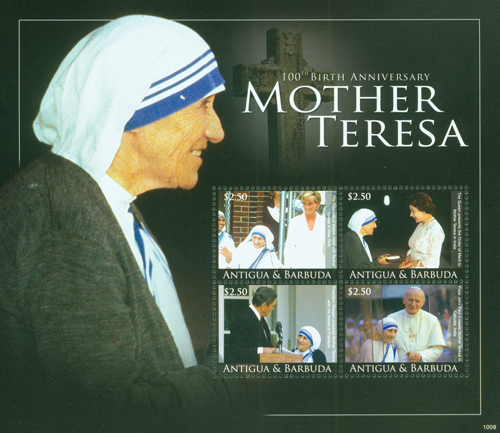
Mother Theresa prepared by receiving medical training and finding a small place to live. With no source of funding, she relied on “Divine Providence” to supply for her needs. She started an open-air school for the children of the slums. When others heard of Mother Theresa’s work, they sent money and some volunteered to help her.
In 1952, she opened the Nirmal Hriday (Pure Heart) Home for Dying Destitutes in Calcutta. Soon after Mother Teresa started her work with the poor of India, young women who wanted to serve with her joined her. After receiving permission from the Vatican, she established the Missionaries of Charity in Calcutta. Its mission was to care for “all those people who feel unwanted, unloved, uncared for… and are shunned by everyone.” Members of the order take vows of chastity, poverty, and obedience like most nuns, but they also vow to give “wholehearted and free service to the poorest of the poor.”
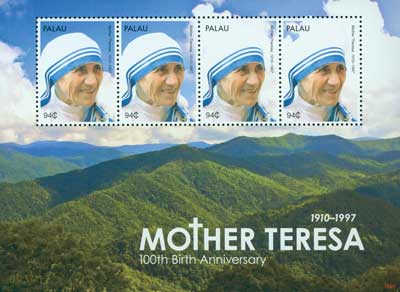
As the work continued to grow, Mother Teresa realized she needed help to serve the spiritual needs of the poor, as well as their physical needs. In 1963, she started a Brother’s Congregation. The men helped with caring for those who suffered from leprosy or homelessness, as well as many others.
In 1965, Pope Paul VI gave Mother Teresa permission to expand her work to other countries. The first house outside India was established in Venezuela and others followed rapidly. Today there are over 4,500 workers in 133 countries.

Hers was a life dedicated to sacrifice and service, to the healing and comfort of those who were sick, needy, and dying – the “poorest of the poor.” For nearly 50 years, Mother Teresa lived among the most desperate inhabitants of Calcutta. Her work was an inspiration to millions and earned her worldwide admiration. For her tireless dedication to the needy, Mother Teresa received a number of awards during her life. These included the Nobel Peace Prize and the Medal of Freedom.
In 1979, upon hearing she would receive the Nobel Peace Prize, Mother Teresa stated, “I accept the prize in the name of the poor. The prize is the recognition of the poor World. Jesus said, ”˜I am hungry, I am naked, I am homeless’. By serving the poor, I am serving Him.”
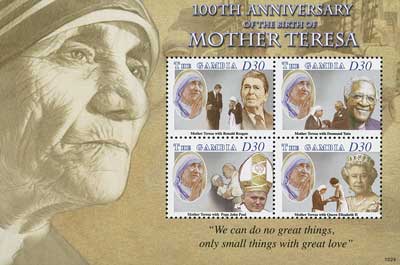
In her acceptance speech, Mother Teresa thanked God and then shared a prayer of St. Francis of Assisi. She went on to say, “There is so much suffering, so much hatred, so much misery, and we with our prayer, with our sacrifice are beginning at home. Love begins at home, and it is not how much we do, but how much love we put in the action that we do. It is to God Almighty – how much we do it does not matter, because He is infinite, but how much love we put in that action. How much we do to Him in the person that we are serving.”
On June 20, 1985, President Reagan held a ceremony in the Rose Garden to award the Medal of Freedom to Mother Teresa. He called her a special and revered guest and said her work was “not special work, not unusual work for her, but everyday work that is both special and urgent in its own right.” Though Mother Teresa wasn’t a U.S. citizen, the President considered her a national hero. He said, “The goodness in some hearts transcends all borders and all narrow nationalistic considerations.” Reagan called her a citizen of the world.
In accepting the award, Mother Teresa said she received the medal in the name of millions of poor people. She said America is a place that offers love and hope to suffering people. As an example of the country’s generosity, Mother Teresa mentioned a fellow nun in Ethiopia who was desperately looking for relief for her starving nation. Mother Teresa wrote to President Reagan to ask for help, and food was sent to Ethiopia. At the end of her acceptance speech, she encouraged her listeners to pray, stating prayer leads to love and peace. The inscription on the Medal of Freedom plaque referred to Mother Teresa as the “saint of the gutters.”
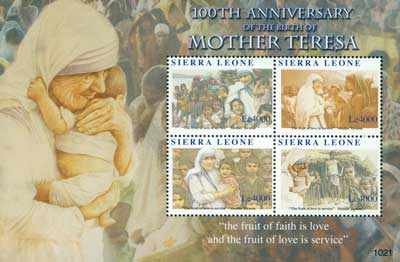
By the early 1990s, Mother Teresa had suffered two heart attacks among other health problems. She offered to resign from her position as head of the Missionaries of Charity, but her fellow sisters voted for her to remain. However, her health continued to fail over the next few years and she stepped down from her position in March 1997. Less than six months later she passed away on September 5, 1997.
Calls for sainthood arose immediately, and in 1999, Pope John Paul II waived the usual five-year waiting period to allow for cases to be presented for her canonization. In 2002, the Vatican recognized her first miracle. In December 2015, Pope Francis was confirmed to have recognized the second miracle needed for sainthood. Her canonization was scheduled for September 4, 2016.
2010 44¢ Mother Teresa
Issue Date: September 5, 2010
City: Washington, DC
Happy Birthday Mother Teresa
When she was 18 years old, Agnes left her home country in Southeastern Europe to join the Sisters of Loreto in Dublin, Ireland. This was her first journey to a distant land with customs and a language that were new to her.
In 1928, she took the name Sister Mary Teresa and began her service to others. She was sent to Calcutta, India, where she taught for many years, eventually becoming headmistress of St. Teresa’s School. She enjoyed the time she spent teaching, but felt that she should be doing more. Mother Theresa believed she was “to give up even Loreto where I was very happy and to go out in the streets.” In order to answer her calling, this dedicated woman once again left the security of what she knew to travel to the unknown.

Mother Theresa prepared by receiving medical training and finding a small place to live. With no source of funding, she relied on “Divine Providence” to supply for her needs. She started an open-air school for the children of the slums. When others heard of Mother Theresa’s work, they sent money and some volunteered to help her.
In 1952, she opened the Nirmal Hriday (Pure Heart) Home for Dying Destitutes in Calcutta. Soon after Mother Teresa started her work with the poor of India, young women who wanted to serve with her joined her. After receiving permission from the Vatican, she established the Missionaries of Charity in Calcutta. Its mission was to care for “all those people who feel unwanted, unloved, uncared for… and are shunned by everyone.” Members of the order take vows of chastity, poverty, and obedience like most nuns, but they also vow to give “wholehearted and free service to the poorest of the poor.”

As the work continued to grow, Mother Teresa realized she needed help to serve the spiritual needs of the poor, as well as their physical needs. In 1963, she started a Brother’s Congregation. The men helped with caring for those who suffered from leprosy or homelessness, as well as many others.
In 1965, Pope Paul VI gave Mother Teresa permission to expand her work to other countries. The first house outside India was established in Venezuela and others followed rapidly. Today there are over 4,500 workers in 133 countries.

Hers was a life dedicated to sacrifice and service, to the healing and comfort of those who were sick, needy, and dying – the “poorest of the poor.” For nearly 50 years, Mother Teresa lived among the most desperate inhabitants of Calcutta. Her work was an inspiration to millions and earned her worldwide admiration. For her tireless dedication to the needy, Mother Teresa received a number of awards during her life. These included the Nobel Peace Prize and the Medal of Freedom.
In 1979, upon hearing she would receive the Nobel Peace Prize, Mother Teresa stated, “I accept the prize in the name of the poor. The prize is the recognition of the poor World. Jesus said, ”˜I am hungry, I am naked, I am homeless’. By serving the poor, I am serving Him.”

In her acceptance speech, Mother Teresa thanked God and then shared a prayer of St. Francis of Assisi. She went on to say, “There is so much suffering, so much hatred, so much misery, and we with our prayer, with our sacrifice are beginning at home. Love begins at home, and it is not how much we do, but how much love we put in the action that we do. It is to God Almighty – how much we do it does not matter, because He is infinite, but how much love we put in that action. How much we do to Him in the person that we are serving.”
On June 20, 1985, President Reagan held a ceremony in the Rose Garden to award the Medal of Freedom to Mother Teresa. He called her a special and revered guest and said her work was “not special work, not unusual work for her, but everyday work that is both special and urgent in its own right.” Though Mother Teresa wasn’t a U.S. citizen, the President considered her a national hero. He said, “The goodness in some hearts transcends all borders and all narrow nationalistic considerations.” Reagan called her a citizen of the world.
In accepting the award, Mother Teresa said she received the medal in the name of millions of poor people. She said America is a place that offers love and hope to suffering people. As an example of the country’s generosity, Mother Teresa mentioned a fellow nun in Ethiopia who was desperately looking for relief for her starving nation. Mother Teresa wrote to President Reagan to ask for help, and food was sent to Ethiopia. At the end of her acceptance speech, she encouraged her listeners to pray, stating prayer leads to love and peace. The inscription on the Medal of Freedom plaque referred to Mother Teresa as the “saint of the gutters.”

By the early 1990s, Mother Teresa had suffered two heart attacks among other health problems. She offered to resign from her position as head of the Missionaries of Charity, but her fellow sisters voted for her to remain. However, her health continued to fail over the next few years and she stepped down from her position in March 1997. Less than six months later she passed away on September 5, 1997.
Calls for sainthood arose immediately, and in 1999, Pope John Paul II waived the usual five-year waiting period to allow for cases to be presented for her canonization. In 2002, the Vatican recognized her first miracle. In December 2015, Pope Francis was confirmed to have recognized the second miracle needed for sainthood. Her canonization was scheduled for September 4, 2016.










